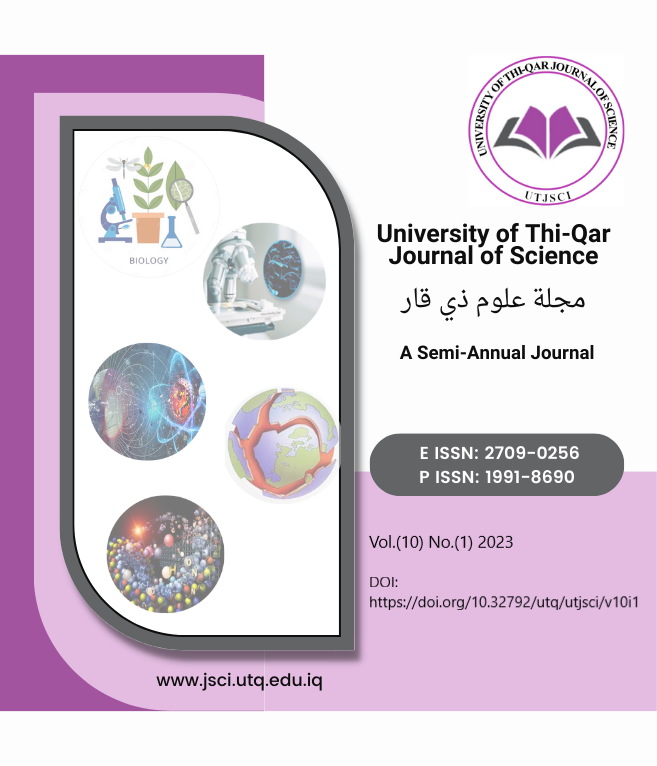Isolation and identification of Gram negative bacteria that cause diarrhea
DOI:
https://doi.org/10.32792/utq/utjsci/v10i1.1059Keywords:
Diarrhea, API 20 E, Antibiotics resistance.Abstract
This study was conducted to isolate some types of bacteria that cause diarrhea in humans, and 350 stool samples were collected from all ages of both sexes who suffer from diarrhea in Al-Shatrah General Hospital, Bint Al-Huda Hospital, and the Public Health Laboratory in Thi-Qar province. Morphological traits routine and advanced biochemical tests were adopted in this study, The results showed that the percentage of diarrhea-causing bacteria isolates in stool samples was (5.71%), Salmonella (4) (20%), Aeromonas (2) (10%), Enterobacter (14) (70%). Enterobacter had the highest rates of resistance to Cefotaxime/clavulanic acid (28.571%), while Aeromonas had the highest rates of sensitivity to the same antibiotic (50%).
References
H. Shen et al., “The 12 gastrointestinal pathogens spectrum of acute infectious diarrhea in a sentinel hospital, Shenzhen, China,” Front. Microbiol., vol. 7, p. 1926, 2016.
T. Afum et al., “Diarrhea-Causing Bacteria and Their Antibiotic Resistance Patterns Among Diarrhea Patients From Ghana,” Front. Microbiol., vol. 13, 2022.
R. Coico, “Gram staining,” Curr. Protoc. Microbiol., no. 1, p. A-3C, 2006.
R. B. Moyes, J. Reynolds, and D. P. Breakwell, “Differential staining of bacteria: gram stain,” Curr. Protoc. Microbiol., vol. 15, no. 1, p. A-3C, 2009.
H. Akhondi and K. A. Simonsen, “Bacterial Diarrhea,” 2019.
M. L. Bayot and B. N. Bragg, “Antimicrobial susceptibility testing,” 2019.
C. C. Cherneck and B. J. Berger, “Salmonella: Rectal Culture, Swab Diagnostic’’In: Laboratory Test and Diagnostic Procedures.” Published by Saunders, an imprint of Elsevier Inc, 2008.
G. W. Procop, D. L. Church, G. S. Hall, and W. M. Janda, Koneman’s color atlas and textbook of diagnostic microbiology. Jones & Bartlett Learning, 2020.
A. William, S. Satija, and R. Kaur, “Bacterial etiology of diarrhoea in a tertiary care hospital,” Int. J. Recent Sci. Res, vol. 11, pp. 39022–39024, 2020.
H. Shen et al., “Prevalence, serotypes, and antimicrobial resistance of Salmonella isolates from patients with diarrhea in Shenzhen, China,” BMC Microbiol., vol. 20, no. 1, pp. 1–10, 2020.
Y. Senderovich, S. Ken-Dror, I. Vainblat, D. Blau, I. Izhaki, and M. Halpern, “A molecular study on the prevalence and virulence potential of Aeromonas spp. recovered from patients suffering from diarrhea in Israel,” PLoS One, vol. 7, no. 2, p. e30070, 2012.
R. Subashkumar, T. Thayumanavan, G. Vivekanandhan, and P. Lakshmanaperumalsamy, “Occurrence of Aeromonas hydrophila in acute gasteroenteritis among children,” Indian J. Med. Res., vol. 123, no. 1, p. 61, 2006.
K. khalaf Al-aawadi, “Phenotypic and Molecular Identification of Cronobacter sakazakii Isolated from Clinical Specimens in Thi-Qar Province,” Univ. Thi-Qar J. Sci., vol. 9, no. 1, pp. 62–67, 2022.
J. K Alkhazraji, W. Sadeq Alwazni, and N. Hashim Kaduim, “Study Antibacterial Activity of Lactobacillus brevis Against Escherchia coli and Enterobacter aerogenus Causes Diarrhea Among Children in Holy City of Karbala.,” J. kerbala Univ., vol. 10, no. 4, pp. 193–202, 2014.
S. Khanal, M. Kandel, and M. P. Shah, “Antibiogram pattern of Escherichia coli, Salmonella spp. and Staphylococcus spp. isolates from broiler chicken,” Nepal. Vet. J., vol. 36, pp. 105–110, 2019.
X. Qin et al., “Antibiotic resistance of Salmonella Typhimurium monophasic variant 1, 4,[5], 12: I:-in china: a systematic review and meta-analysis,” Antibiotics, vol. 11, no. 4, p. 532, 2022.
A. M. Beyene, M. Gezachew, D. Mengesha, A. Yousef, and B. Gelaw, “Prevalence and drug resistance patterns of Gram-negative enteric bacterial pathogens from diarrheic patients in Ethiopia: A systematic review and meta-analysis,” PLoS One, vol. 17, no. 3, p. e0265271, 2022.
A. Huttner et al., “Oral amoxicillin and amoxicillin–clavulanic acid: properties, indications and usage,” Clin. Microbiol. Infect., vol. 26, no. 7, pp. 871–879, 2020.
M. M. S. Dallal, R. M. N. Fard, M. K. Talkhabi, L. Aghaiyan, and Z. Salehipour, “Prevalence, virulence and antimicrobial resistance patterns of Aeromonas spp. isolated from children with diarrhea,” Germs, vol. 6, no. 3, p. 91, 2016.
J. Parra-Flores et al., “Virulence and antibiotic resistance profiles of Cronobacter sakazakii and Enterobacter spp. involved in the diarrheic hemorrhagic outbreak in Mexico,” Front. Microbiol., vol. 9, p. 2206, 2018.
K. Harada et al., “Phenotypic and molecular characterization of antimicrobial resistance in Enterobacter spp. isolates from companion animals in Japan,” PLoS One, vol. 12, no. 3, p. e0174178, 2017.
G. P. Bodey and B. Le Blanc, “Piperacillin: in vitro evaluation,” Antimicrob. Agents Chemother., vol. 14, no. 1, pp. 78–87, 1978.
Downloads
Published
License
Copyright (c) 2023 University of Thi-Qar Journal of Science

This work is licensed under a Creative Commons Attribution 4.0 International License.













